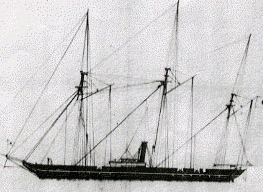Japanese warship Banryū facts for kids
class="infobox " style="float: right; clear: right; width: 315px; border-spacing: 2px; text-align: left; font-size: 90%;"
| colspan="2" style="text-align: center; font-size: 90%; line-height: 1.5em;" | 
|} Banryū (蟠龍, Coiled Dragon) was a special ship in Japan's history. It belonged to the Tokugawa Navy. After the shogunate's rule ended, the ship was used by loyal supporters of the Tokugawa family. They were part of the Republic of Ezo during a big conflict called the Boshin War in Japan.
Banryū was an armed ship with an iron hull. It was a steam-powered `schooner`, which means it used both steam and sails to move. The ship was about 41.8 meters long, 5.45 meters wide, and 3.23 meters deep. It weighed 370 tons and carried four 12-pounder bronze cannons for defense.
Contents
- First Modern Naval Battle
- Transporting the Shōgun
- Joining the Republic of Ezo
- Battle of Hakodate Bay
| History | |
|---|---|
| Name | Banryū (ex Emperor) |
| Ordered | 1856 |
| Builder | R & H Green of Blackwall |
| Laid down | 1856 |
| Launched | 1856 |
| Commissioned | 1857 |
| Decommissioned | 1888 |
| Fate | Broken up late 1890s |
| General characteristics | |
| Displacement | 370 long tons (376 t) |
| Length | 41.8 m (137 ft 2 in) |
| Beam | 5.45 m (17 ft 11 in) |
| Draught | 3.23 m (10 ft 7 in) |
| Propulsion | Steam engine |
| Sail plan | Schooner |
| Armament | 6 × 12-pounder cannon |
A Royal Gift from England
Banryū was built in England by R&H Green at the Blackwall Yard. Its original name was HMY Emperor. On August 26, 1858, the ship was given as a gift to the Tokugawa government. James Bruce, 8th Earl of Elgin presented it on behalf of Queen Victoria of England.
This gift celebrated the signing of the Anglo-Japanese Treaty of Amity and Commerce. This treaty was an important agreement between Britain and Japan. The ship was meant to be a royal yacht, so its inside was very fancy with sculptures and mirrors.
Banryū in the Boshin War
During the Boshin War, Banryū played a key role in several events.
On January 28, 1868, Banryū took part in the Naval Battle of Awa. This was a very important battle because it was the first time two modern naval fleets fought each other in Japan.
Transporting the Shōgun
Later, on April 11, after the Fall of Edo, Banryū was used for a special mission. It transported the Shōgun Tokugawa Yoshinobu from Edo to Sumpu. This was where the Shōgun went into exile after imperial forces took over Edo.
Joining the Republic of Ezo
Under the command of Bankichi Matsuoka, Banryū was one of the ships taken by Enomoto Takeaki. He and other Tokugawa loyalists used these ships to escape to Hokkaido. There, they tried to create their own government, the Republic of Ezo.
Battle of Hakodate Bay
In March 1869, Matsuoka was sent to join the Naval Battle of Miyako Bay. However, bad weather forced him to return to Hachinohe.
Banryū later fought in the Naval Battle of Hakodate Bay in May 1869. During this battle, it sank an Imperial navy warship called Chōyō Maru. This was the first time a modern warship was sunk by another ship in combat in Japanese history.
Towards the end of the battle, Banryū ran out of ammunition. It also had severe damage from many hits. The crew had to beach the ship near Benten Daiba and set it on fire. Luckily, the fire went out before it could completely destroy the vessel.
Later Life of the Ship
An Englishman later salvaged Banryū. After being repaired and rebuilt in Shanghai, the ship was renamed the SS Emperor. In 1873, it returned to Japan as Raiden Maru (雷電丸). It was then used to transport settlers and supplies to Hokkaido.
The Imperial Japanese Navy bought the ship in 1877 and renamed it Raiden. It served as a training vessel until January 1888. After that, its weapons were removed. It became a whaling ship operating out of Kochi. Later, it was used as a transport ship, passing through several owners. Finally, it was taken apart and scrapped in 1897.
Images for kids


